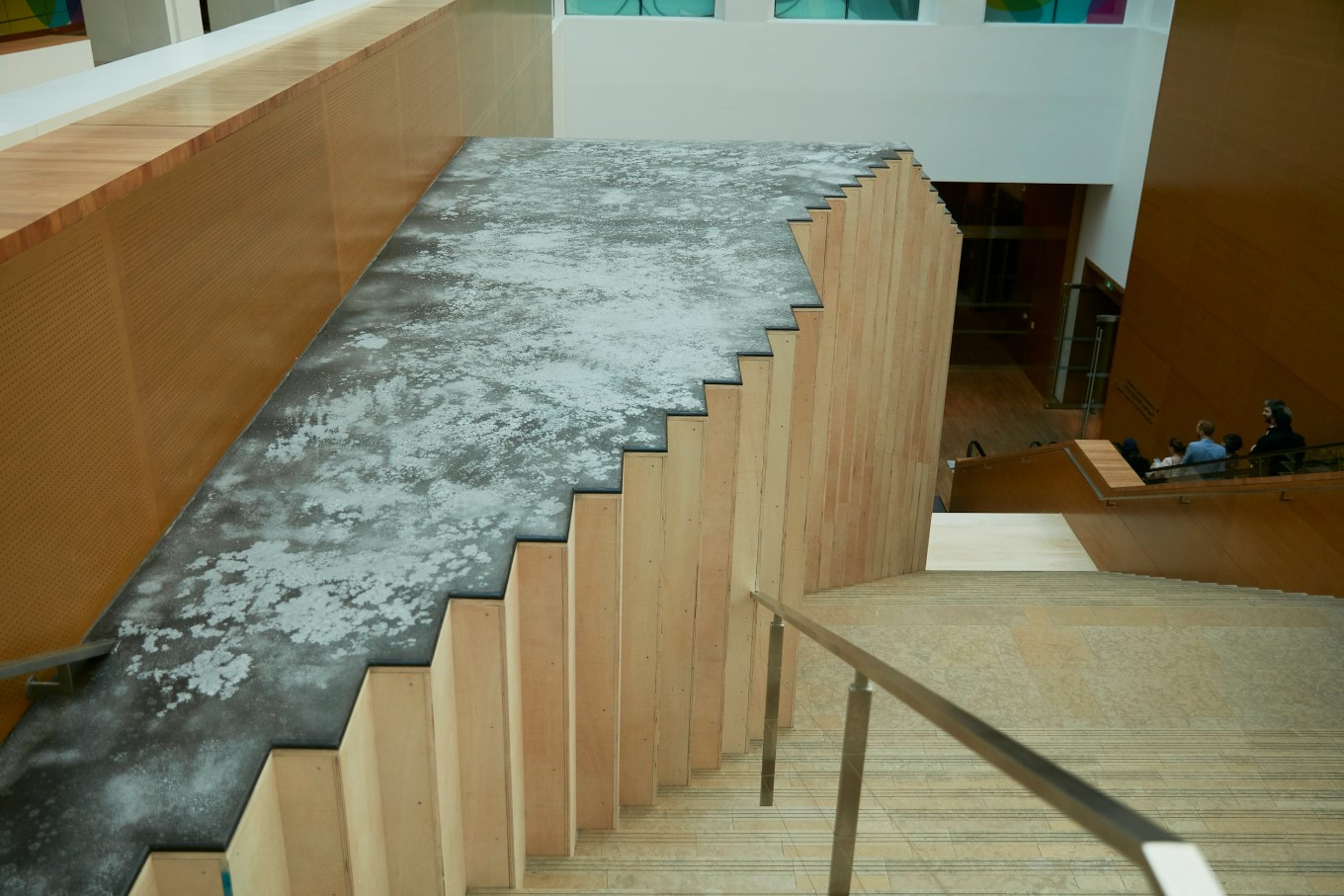Popular Reads
Top Results
Can't find what you're looking for?
View all search resultsPopular Reads
Top Results
Can't find what you're looking for?
View all search resultsBoedi Widjaja's subterranean sonic temple a highlight of 2019 Singapore Biennale
"Black—Hut, Black—Hut", Widjaja’s ideas about home and the complexities of belonging in a transient world initially came to life through a distinct dream about five years ago.
Change text size
Gift Premium Articles
to Anyone
Boedi Widjaja is an artist with one foot positioned in two similar, yet disparate worlds.
Since focusing on contemporary arts in 2012, he has been exhibited in prestigious events representing Singapore in the Live Art program of the Diaspora Pavilion at the 57th Venice Biennale (2017); Jerusalem Biennale (2017); “From East to the Barbican” at Barbican (London, 2015) and “Bains Numériques #7” at Enghien-les-Bains (France, 2012).
Boedi’s art intersects graphic design, architectural and fine-art principles while including performance and explorations and interactions with alternative cultures.
“Black—Hut, Black—Hut”, Boedi’s ideas about home and the complexities of belonging in a transient world initially came to life through a distinct dream about five years ago. In his vision, he saw one of the pioneers of modern architecture Charles-Édouard Jeanneret (1887-19650), also known as Le Corbusier, exploring and contemplating his ideas about building, dwelling and being.
The architectural-sound proto-structure has evolved through three individual installations. “Black—Hut” was first commissioned and presented at the Institute of Contemporary Arts Singapore in 2016, as a Singapore Biennale affiliate project. The second and third installations - both titled “Black—Hut, Black—Hut” - were co-commissioned by the Queensland Art Gallery & Gallery of Modern Art (QAGOMA) and the Singapore Art Museum.
“Black—Hut, Black—Hut” has been on display at the National Gallery of Singapore (NGS) from November last year until March 22.
Entitled “Every Step in the Right Direction”, the Singapore Biennale 2019 presents 150 works by 77 artists and art collectives from 36 countries and territories displayed at the NGS, Gillman Barracks, LaSalle College of the Arts and other various historic locations and public spaces. Helmed by artistic director Patrick Flores, the biennale seeks to address questions and ideas of how humanity can approach the past, present and future, looking to create a pathway to brighter and more harmonic times ahead.
Memories and impressions of the Surakarta royal palace located close to his childhood home and the sounds of the traditional Javanese gamelan floating gracefully upon the late afternoon breeze are encoded upon Boedi’s psyche. They ignite a wonderful sense of nostalgia that has helped inspire his installation.
“Three years ago I discovered an online library of recordings of a 100-year-old gamelan - Gamelan Kjai Paridjata - that was acquired from the Surakarta palace,” explained the artist.
”I then rearranged the 131 recordings within a matrix and displaced and inverted each sound out of its original position to generate the sequential pulse-like sounds 'Datum' [the musical piece in the installation],” he said. “The sounds are alien yet somehow feel at home. Perhaps I've grown to be familiar with their distorted, displaced qualities.”
“Black—Hut, Black—Hut” is positioned on a flight of stairs leading from the ground floor down to the basement in NGS’ Coleman courtyard. It exists in the space between the two physical levels of the historic building reflecting the deep-seated and ongoing theme at the core of Boedi’s artworks - of the diaspora, isolation, of the complexities of hybridity and the bridging of multiple cultures, along with his relationship with the physical surrounds where he intuitively feels grounded and at home.
Born in 1975 in Surakarta, he has lived in Singapore since he was 9 years old. His parents, who are Chinese-Indonesians, sent him to Singapore to avoid the racial tensions under Soeharto’s New Order.
Boedi coordinates the linear planes of the steps into the vertical cladding of the structure, a continuation of the horizontal line aspect so that it appears grounded into the gallery as one harmonic and unified form. The striking exterior cocoons an inner sanctum, the imagined center of “Black—Hut, Black—Hut”. From this unusual space “Datum” radiates a distinct, yet strangely assuring atmospheric sound.
A salt-infused black concrete membrane upon the surface of the steps and the roof of the structure introduces an ecosystem to the installation. This encourages efflorescent crystallization blooms as the material sweats in the tropical climate of Singapore.
"When I started to think about concrete, the material triggered memories of my transition from Surakarta to Singapore. From a less urbanized environment to a very urbanized city in Southeast Asia," said Boedi.
“When I first came to Singapore in 1984, the constructed landscape was very different from that in Surakarta. I was in awe of the row upon row of public flats, large-scale mass housing structures, with ordered recto-linear geometry and the repetition of elements that were very different, all built in concrete. This visual memory has seeped into my design ideas.”
For the NGS exhibition, he was drawn to the newly added basement in the building. “So much of the history that goes beyond the 200 years of Raffles belongs underground within an archeological state,” added Boedi.
“In Singapore, we look to the underground as a means to project into the future by building structures. There is an exciting anachronistic quality where the future and the past intersect. This expresses a sense of time that I associate with my migrant experience – in being in an in-between space-time.”
Boedi further explained that he tried to incorporate several architectural traditions into his work, including Javanese architecture and the mandala – which is also present at the Surakarta royal palace.
“When I think about the center of the ‘Black—Hut’, I think firstly of a sense of an anchor that is not present, yet which I yearn for. While the mandala-center is a concentration of cultural, historical and political power, it also points to the memory of my first home being located near to the Keraton – the universal center according to local Javanese beliefs,” he said.
To audiences exploring Boedi’s work for the first time “Black—Hut, Black—Hut”, may seem indeed as an alien structure. So much so that they may be more comfortable to look, observe and enjoy it from various positions on the stairs, escalators and upper floors of the NGS, without the need for closer inspection.
To fully appreciate it however, one would benefit from observing and understanding his previous installation at the APT in 2018 and recognize the two installations as a diptych. His APT installation in the Queensland Art Gallery referenced the ground level and a gap between an elevated structure, this installation is, however, a subterranean mirror of that work.
“Black—Hut, Black—Hut” is configured, says Boedi, “to reference the gap between ground and land in the tropical and subtropical vernacular houses built on raised floors, such as the Javanese joglo, the Queenslander, and the Malay houses. Ground is shorthand for me to speak about grounding, belonging, rootedness.”
For me, the work is visually and conceptually fascinating, especially as I have my interest in architecture and how structures and dwellings influence the human experience. On another level, this work entertains my ideas about my spiritual essence in relation to our physical world, and my fragmented feelings about belonging.
Both beautiful and powerful, yet unusual in its physical and sonic presence, “Black—Hut, Black—Hut” is an intricate work charged with layers of meaning and focal points to experience its varying degrees of subtleties of intimacy and monumentality. The visual rhythms of the structure are exhilarating, and fascinating in their linear character from the inner repetitive mandala aspect to the external design.
We may fully appreciate the audio rhythms and their fragmented otherworldly heartbeat of its inside installation’s “nerve center”. Between the silence, the sounds are indeed alien, yet at the same time from a comforting organic source.
“Black—Hut, Black—Hut” captures an intimate essence of the modern human experience. Of a duality that touches on the present, future and past – and of a species disconnected and out of harmony with the tempo of universe and nature - lost and yearning for belonging, somewhere within time and space. (wng)











